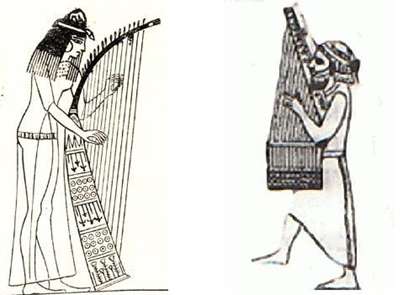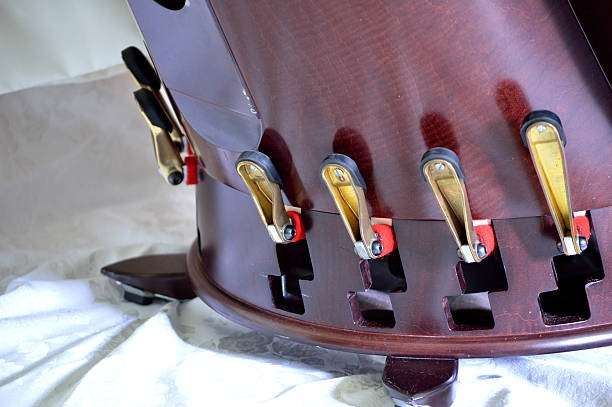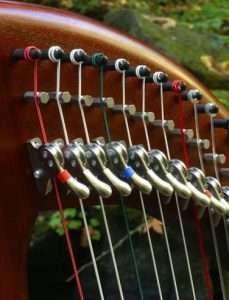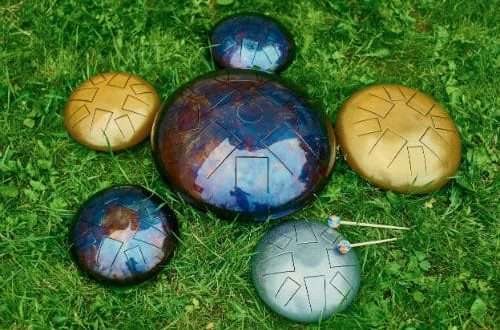
Harps. Types of harps. How to choose a harp?
The harp is a stringed plucked instrument.
It is one of the most ancient musical instruments. Harps are also found during excavations of Sumerian settlements, and in ancient Egyptian paintings, and are mentioned several times in the Bible. With its magical sound, the harp has conquered the hearts of millions of people for thousands of years. Different peoples had harps of different systems, shapes and types. The tool has been modified and improved many times. In Europe, the harp has gained great popularity since the XVIII century. It is known that Empress Elizaveta Petrovna liked to play on it.
Now the harp is used as a solo and ensemble, orchestral instrument in various genres and styles of music. From this article you will learn what modern harps are like and which instrument is better to buy.
Great pedal harp
It is an academic solo and ensemble instrument. It is the pedal harp that in most cases is played by professional harpists in orchestras, it is taught to play in music schools and conservatories.
Although the harp appeared in Europe a very long time ago (the Italian composer C. Monteverdi wrote parts for it back in the 17th century), the instrument gained real popularity only in the second half of the 18th – early 19th centuries. This is due to the fact that the pedal harp has been developed for a long time, all the time improving the mechanism . The first pedal harp was introduced by the Bavarian Jakob Hochbrücker back in the 18th century, but the instrument acquired its modern look only in the 19th century.
The French master Sebastian Erard, relying on the experiences of his predecessors, made it possible, due to the pedal mechanism , to play chromatic semitones both up and down on the harp (the Hochbrücker harp had only one move).
The mechanism is as follows: 7 pedals are responsible for the strings of any note (“do”, “re”, “mi”, “fa”, respectively). Each pedal has three position options: “becar”, “flat” and “sharp”. Putting the pedal in a certain position, the musician raises or lowers all the strings of this pedal. This happens by increasing or decreasing the tension of the strings. This mechanism allowed the instrument to become more technical and perfect, since before that the performer was forced, while playing the instrument, to pull the hooks with his left hand to raise or lower the tone, but now this function has been given to the legs.

(pedal mechanism of the harp)
From this moment, the harp becomes a full member of a large symphony orchestra. It is found in the scores of Beethoven, Berlioz, Debussy, Wagner, Tchaikovsky, Rachmaninov, Shostakovich and many other composers. Often the harp imitates the sounds of a lute or a guitar. So, for example, in Rachmaninov’s opera Aleko, a young gypsy, while singing a romance, allegedly plucks the strings of a guitar on stage, but a harp accompanies the singer from the orchestra. The instrument is often found in works for chamber ensembles, and there are solo works written both for the harp and arranged for it.
The range of the pedal harp is from the “D-flat” counteroctave to the “G-sharp” of the fourth octave. Harp strings are quite expensive, so most often they are not bought as a set, but replaced as needed.
Today there are many firms specializing in the production of harps. The most famous of them are the French ” Camac” and the American “Lyon&Healy”.
Lyon & Healy was founded in Chicago in 1864. The instruments of this company are often called “American” by harpists. These harps are often played by professional musicians in theater and philharmonic orchestras.
It was on the basis of the prototype of American instruments that the Soviet “Leningradka” harps were made, which appeared only in 1947. These harps have less advanced mechanics, but they are still used as student instruments in music schools and conservatories. Nowadays, the St. Petersburg factory is the only one in Russia that produces harps.
Large dimensions make the instrument mostly stationary, so at home and in the orchestra, performers play different harps.
Levers harp
Often it is called the ” Celtic ” harp, which is not very true from a historical point of view. The tool is called “levers” because it has a certain mechanism for rebuilding the tool. It is very similar to the mechanism of the late “Baroque” hook harp. The one that was before the invention of the first pedal instruments. This mechanism appeared in the 17th century. With the help of the “hook”, the tone of a particular string was raised or lowered. Up to this point, harps were only diatonic, or had additional “chromatic” strings. There are several types of lever harp mechanism, but they differ only slightly. The means for lifting the strings themselves are in the form of “levers”, and are in the form of “blades”. At the same time, the working principlethe mechanism does not change much.
 This type of instrument is less commonly used in a symphony orchestra. Levers harps are both very small (22 strings), which allows you to hold the instrument on your knees, and large (38 strings). Levers harps with 27 and 34 strings are also common. Levers harps are played by both professionals and novice harpists and amateur musicians.
This type of instrument is less commonly used in a symphony orchestra. Levers harps are both very small (22 strings), which allows you to hold the instrument on your knees, and large (38 strings). Levers harps with 27 and 34 strings are also common. Levers harps are played by both professionals and novice harpists and amateur musicians.
The left harp is also actively used in modern music. They became especially popular in the second half of the 20th century due to the trends of popular culture, the fashion for ethnic, oriental and Celtic music. This served to fix the name of the instrument in the mass consciousness as the “ Celtic ” harp. In fact, even a “neo- Celtic ” harp can be called this instrument with a big stretch.
How to choose a harp
Although the harp is not the most difficult instrument to master, it still requires a lot of hard work and effort. When choosing a harp, like any other musical instrument, it is best to consult a professional. However, if you are planning to learn how to play the harp yourself and are buying an instrument for yourself, you need to decide what you want. If you like the sound of the instrument and its romantic image, but you have not decided what type of instrument you want to play, then you should take a closer look at small lever harps. For home music-making, the performance of light pleasant works, this instrument will be quite enough.
If you choose a harp for a child, then a mandatory preliminary consultation with the teacher is necessary, since there are several methods and opinions related to which instrument it is necessary to start teaching children on. So, for example, in Moscow, kids are taught to play left-handed harps, and in St. Petersburg they are taught to play large pedal harps, although everywhere there are exceptions. However, the child needs to immediately buy a large instrument with a full number of strings.
The harp is one of the most expensive instruments. Moreover, pedal harps are usually much more expensive. Master tools are often inferior in quality to those made by a trusted company. The cost of pedal harps starts from 200,000 rubles and ends in hundreds of thousands of dollars. In many ways, it depends on the company, the sound quality, as well as the materials used.
The price of lever harps, among other things, depends on the number of strings. In addition, some tools are sold without levers (from 20,000 rubles). The manufacturer offers to buy them separately and put only on the “needed” strings. (The price of a set of levers is ≈ 20,000-30,000 rubles). However, this approach is not suitable even for amateurs. The possibilities of such a tool will be very limited. Therefore, it is better to buy an instrument immediately with levers installed on it (from 50,000 rubles with a minimum number of strings).






